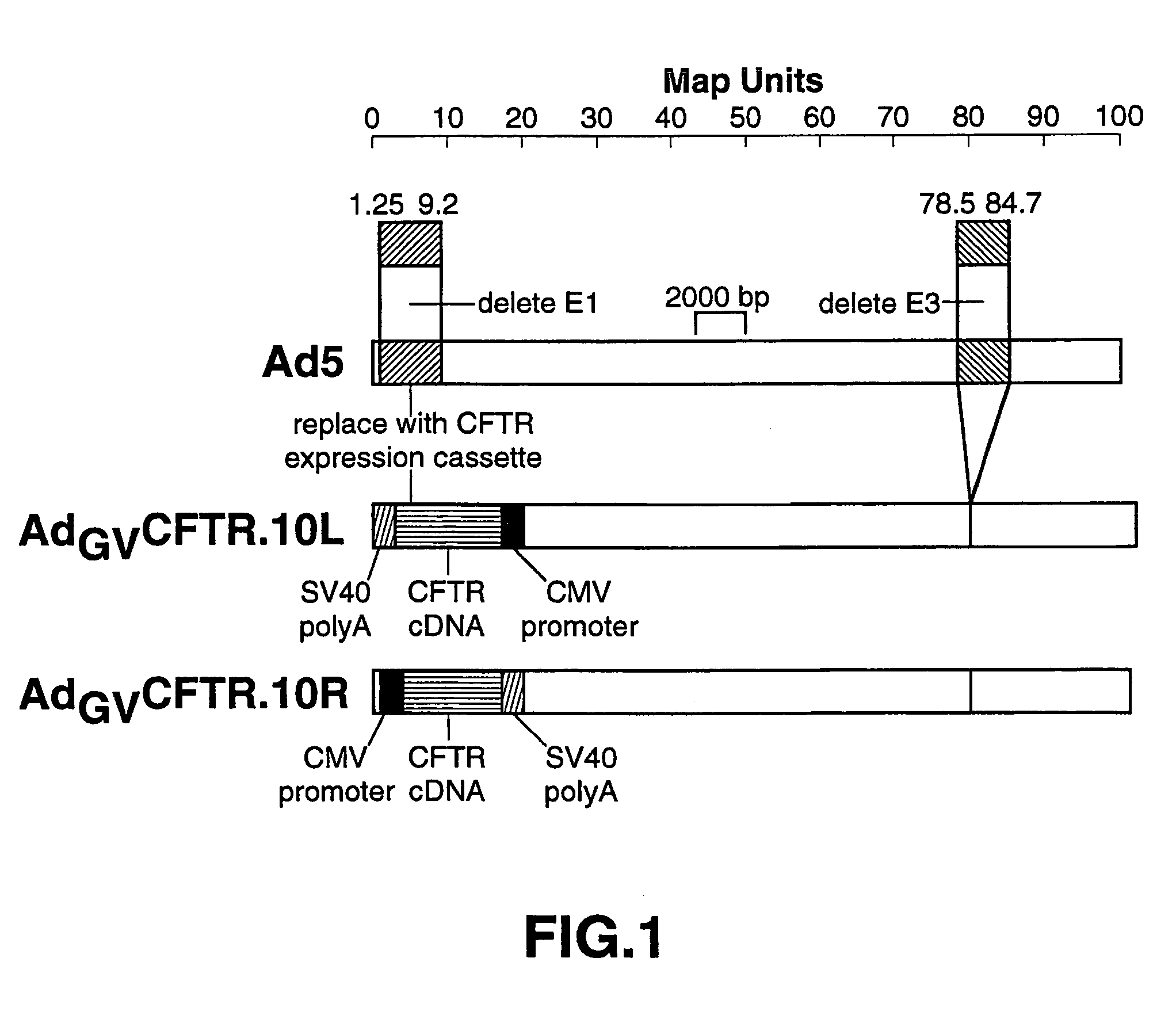Complementary adenoviral vector systems and cell lines
a technology of adenoviral vectors and cell lines, applied in the field of recombinant, multiply deficient adenoviral vectors and complementing cell lines, can solve the problems of limiting the amount of usable space within the adenoviral genome, defective adenoviral vectors, and receptosome rupture and virus release into the cytoplasm of cells
- Summary
- Abstract
- Description
- Claims
- Application Information
AI Technical Summary
Problems solved by technology
Method used
Image
Examples
example 1
[0047]This example describes the generation of one embodiment involving AdGV.10, namely AdGVCFTR.10.
[0048]AdGVCFTR.10 expresses the CFTR gene from the cytomegalovirus (CMV) early promoter. Two generations of this vector have been constructed and are designated AdGVCFTR.10L and AdGVCFTR.10R, dependent on the direction in which the CFTR expression cassette is placed in the E1 region in relation to the vector genome as shown in FIG. 1, which is a set of schematic diagrams of AdGVCFTR.10L and AdGVCFTR.10R.
[0049]The CFTR expression cassette was constructed as follows. pRK5 (Genentech Inc., South San Francisco, Calif.) was digested with Kpn I (New England Biolabs (NEB), Beverly, Mass.), blunt-ended with Mung Bean nuclease (NEB), and an Xho I linker (NEB) was ligated in place of the Kpn I site. The resulting vector was named pRK5-Xho I. pRK5-Xho I was then digested with Sma I (NEB) and Hin dIII (NEB) and blunt-ended with Mung bean nuclease. A plasmid containing the CFTR gene, pBQ4.7 (Dr. L...
example 2
[0052]This example describes the generation of AdGVCFTR.11.
[0053]AdGVCFTR.11 was constructed by means of a single in vivo recombination between 1–27082, i.e., the left arm, of AdGVCFTR.10 and a plasmid (pGV11A, pGV11B, pGV11C, or pGV11D; described in detail below) containing 21562–35935, i.e., the right arm, of Ad5 linearized with Bam HI (NEB) and Sal I (NEB) and into which the various E3 and E4 alterations as described below were introduced.
[0054]The left arm from AdGV CFTR.10 was isolated on a concave 10–40% sucrose gradient, wherein ¼th of the total solution was 40%, after intact AdGVCFTR.10 was digested with Spe I (NEB) and Srf I (Stratagene, La Jolla, Calif.) to yield the 1–27082 bp fragment.
[0055]The right arm was obtained by Bam HI-Sal I digestion of a modified pGEM vector (pGBS). pGBS was generated as follows. pGemI (Promega, Madison, Wis.) was digested with Eco RI and blunt-ended with Klenow, and a Sal I linker was ligated into the vector. The resulting DNA was then digeste...
example 3
[0063]This example describes the generation of AdGVCFTR.12.
[0064]AdGV.12 is characterized by complete elimination of the E4 region. This large deletion allows for insertion of up to about 10 kb of exogenous DNA. More importantly, another region of the genome has become accessible for introduction of foreign gene expression cassettes. This deletion now enables the incorporation of larger expression cassettes for other products. For example, soluble receptors, i.e., TNF or IL-6 without a transmembrane domain so that they are now not attached to the membrane, and antisense molecules, e.g., those directed against cell cycle regulating products, such as cdc2, cdk kinases, cyclins, i.e., cyclin E or cyclin D, and transcription factors, i.e., E2F or c-myc, to eliminate inflammation and immune responses.
[0065]pGV11(O) is altered to produce a right arm plasmid in which the entire E4 region is deleted. The resulting plasmid in which the entire E3 and E4 regions are deleted is named pGV12(O). ...
PUM
| Property | Measurement | Unit |
|---|---|---|
| diameter | aaaaa | aaaaa |
| length | aaaaa | aaaaa |
| volume | aaaaa | aaaaa |
Abstract
Description
Claims
Application Information
 Login to View More
Login to View More - R&D
- Intellectual Property
- Life Sciences
- Materials
- Tech Scout
- Unparalleled Data Quality
- Higher Quality Content
- 60% Fewer Hallucinations
Browse by: Latest US Patents, China's latest patents, Technical Efficacy Thesaurus, Application Domain, Technology Topic, Popular Technical Reports.
© 2025 PatSnap. All rights reserved.Legal|Privacy policy|Modern Slavery Act Transparency Statement|Sitemap|About US| Contact US: help@patsnap.com



